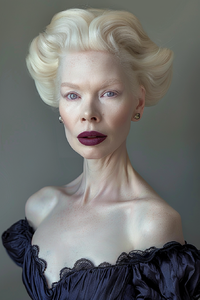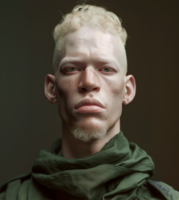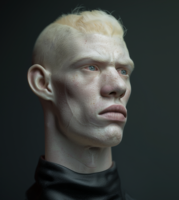Gwhermos Seh2lusonos of the Ghankor tribe, of the H2erh2n̥gw clan
| Personal details | |
|---|---|

| |
| Birth Date | 7627, 5th of Estorun |
| Birth place | Rūdhroskhom |
| Nationality | Hergom Wolgos |
| Party | Red Banner |
| Height | 7'3" (221 cm) |
| Spouse | Gwendhā Septā Welghwosā of the Ghērspōt tribe, of the H1ekwos clan |
| Children | 10 |
| Mother | Gwlela Pér̥gwa of the Ghankor tribe, of the Sephwes clan |
| Father | Seh2lusoS H1r̥dhēsunus of the Ghankor tribe, of the H2erh2n̥gw clan |
| Residence | Nekwehon, Hergom |
| Education | tbc |
| Alma mater | tbc |
| Occupation | Tribal leader |
| Known for | tbc |
| Signature | GwhermosSignature.jpg |
| Heghnom Kawisoos | |
| Status | Active |
| Term Start | 7678 |
Gwhermos Seh2lusonos of the Ghankor tribe, of the H2erh2n̥gw clan is the head of state for Hergom ep swekorwos.
Biography
Early Life and Family Background
Born on the 5th of Estorun, 7627, in the city of Rūdhroskhom located on Neptus Island, Gwhermos hailed from the oldest Wolgos settlement in Kupeya. His birth occurred seven years after the end of the Second Wolgos Trek. His family had settled on the island ten years prior and played a significant role in unifying the traditional Ghankor heritage clans into the modern Ghankor tribe. This tribe specialized in shipbuilding, dry docks, machining, and recycling derelicts into tools and supplies such as cookware and log burners to support resettlement efforts.
At the age of eleven, Gwhermos's clan, H2erh2n̥gw, relocated to the upper Pleudhara River valley to establish a new iron ore mine and steel furnaces near a new dam constructed by the Skēlghēu tribe. In alliance, both tribes built a new industrial zone and charcoal plant to facilitate steel production using electric arc furnaces. This industrial zone grew into the city of Kérsróm, named after the piles of native corpses and bones that crowded the main road during a time when captured natives died by the thousands while building the Kérsróm-Wódmór dam.
Rise in the Ghankor Tribe
In 7648, Gwhermos became foreman of the Ghankor Wire and Machining Concern in Kérsróm, and five years later, he was appointed as a tribal representative in the tribe's hierarchy. By 7658, Gwhermos transferred his directorship and became a full-time tribal minister, representing the Kérsróm district of the Ghankor tribe in the intra-tribal council.
With the start of the Second Coalition War in 7663, Gwhermos served as an auxiliary officer for logistics in the Azemmur Bay front, excelling in facilitating the transport of supplies to the battlefront and managing newly acquired Imbatu slaves and POWs. In 7665, he was elevated to the Ghankor inner circle, becoming a Hregwis Wl̥kwos in the Gweḱwōntiyo Hregwes (tribal council).
In 7666, Gwhermos married Gwendhā Septā Welghwosā of the Ghērspōt tribe, daughter of an inner circle member. This marriage facilitated partnerships between the Ghankor, Skēlghēu, Ghērspōt, and Wēymisdh tribes, forming the Wérus Healthcare Federation and expanding the production of heavy engineering equipment. Gwendhā Septā played a crucial role in increasing Gwhermos's influence in the Gweḱwōntiyo Hregwes, using her social circle to maneuver political support and opposition.
Ascension to Heghnom Kawisoos and career
In 7678, on the 32nd of Halyga, a challenge was brought against the incumbent Heghnom Kawisoos, resulting in a heated session with accusations and skirmishes. The session ended with the incumbent stepping down at 4 am on the 33rd. A resignation party was held, and on the 34th, Gwhermos was proclaimed the new Heghnom Kawisoos in a televised ceremony, with all tribes ratifying his appointment.
From 7681 to 7683, Hergom fulfilled its emancipation obligations under the Accord for Restrained Arms and International Harmony, dismantling institutions that created a large serf and slave population. Laws were enacted to provide universal guarantees for non-Wolgos within Hergom, along with regulations mandating the labour of newly emancipated populations in exchange for wages. Gwhermos championed regulations to restrict the movement of non-Wolgos populations and required them to register with employment agencies for access to movement permits, financial services, and protections.
Since 7683, Gwhermos has navigated Hergom through an era of emancipation, addressing security threats such as the resurgence of sectarian violence between the Nara and Vanara denominations of Chalam and Gahnam faiths. His administration is formulating new legislation and strategies to deal with calls for representation and foreign hominid rights. Under the Gwhermos Emancipation Doctrine, non-Wolgos are to remain subjects and protectorates of the Wolgos, with representation limited to appointed local elites under the Bureau of Eokoesr Affairs.
Politics
Personal life and Health
Gwhermos Seh2lusonos is an older Wolgos man of sixty-eight years, close to his seventh decade when many Wolgos men elect to undergo their death pilgrimage, Seh2lusonos has made allusions that he will not undergo the pilgrimage until it is inevitable as his priority is serving the Wolgos people and the state above all. In public, he has an image of shrewdness and calculative politics and is seen by many common folks as a father figure; in private, his age is catching up with his stamina, and his health is declining.
Wolgos men of advanced age often boast the signs of a difficult life and Seh2lusonos certainly has lived a life with difficulties. During his childhood, the fledgling Wolgos tribal national was in deep poverty and struggled with nature and natives. His family, being part of the prestigious Ghankor tribe, were entrepreneurs who ran a workshop that recycled metal debris and used pig iron to create cooking pots and utensils; their modest workshop grew into an important tribal concern, but in the early years, the family lived hand to mouth, and many of their employees did. Food security was not always guaranteed, and Seh2lusonos worked from the age of eight, along with family and employees, dismantling shipwrecks into usable steel, backbreaking work that left lingering pains that are now increasingly worsening. Seh2lusonos, for the past decade, has become inseparable from his fine silver and ebony walking stick, which he uses to support his aching frame and is now an inseparable part of his image.
Wolgos's eyesight has a deserved notoriety for its poor quality in comparison to human visual acuity, and Seh2lusonos' eyesight, after years of being a foreman and manager at electric arc furnaces, has deteriorated to the point he is now partially blind.
Seh2lusonos has become increasingly reliant on his closest allies and specifically his wife, Gwendha Septa Welghwosa, to keep the
Gweḱwōntiyo Hregwes in check. His rivals have been circling for years, and the Hregwis Wl̥kwos of the chamber are increasingly agitated by signs of his decline. His rivals often callously say that he is "circling the woods." to suggest he should be deposed to allow him to undertake his final pilgrimage. Nevertheless, three leadership challenges were thwarted before they even reached the tribal council chamber through brilliant political manoeuvres where his wife played a crucial role.
Gwendhā Septā Welghwosā of the Ghērspōt tribe, of the H1ekwos clan

Family
| Gwhermos II Gwhermosonos | Kréuksos Gwhermosonos | Ghósdhghos Gwhermosonos | Sépkwol Gwhermosonos | Dhéler Gwhermosonas | Mebhā Gwhermosonas |
|---|---|---|---|---|---|
 |
 |
 |
 |
 |
 |
| Age: 33, Birth date: 17th of Vetrun, 7662 | Age: 27, Birth date: 19th of Estorun, 7668 | Age: 25, Birth date: 20th of Blots, 7670 | Age: 21, Birth date: 22nd of Herfa, 7674 | Age: 20, Birth date: 23rd of Halyga, 7675 | Age: 18, Birth date: 40th of Wintar, 7677 |
| Lieutenant in the H2egmegh2, Currently stationed with the peacekeeping force in Ratna | Hlrike Bherghmegh2 Sképwrōtskwos ("Council Knight"), rumoured to have served in operations in the Gate of Light, currently on tour in Bule. | Junior tribal minister for the Ghankor tribe | Professional Xorgis player for the Wérunodhuros. | Direct sales queen and celebrity for Gwenwos Phorus cosmetics. | |
| Pesunā Gwhermosonas | Nérthwē Gwhermosonos | Hlādwē Gwhermosonos | H1ekwos Gwhermosonos | Gweln̥sā Gwhermosonas | Selwī Gwhermosonos |
 |
 |
 |
 |
 |
 |
| Age: 16, Birth date: 40th of Solma, 7679 | 26th of Vetrun, 7680 | 26th of Vetrun, 7680 | Age: 13, Birth date:18th of Estorun, 7682 | Age: 12, Birth date:19th of Blots, 7683 | Age: 10, Birth date:39 nd of Halyga, 7685 |
| Died age 3 - Death pilgrimage - Twin of Hlādwē | Died age 3 - Death pilgrimage - Twin of Nérthwē | Youngest child |
